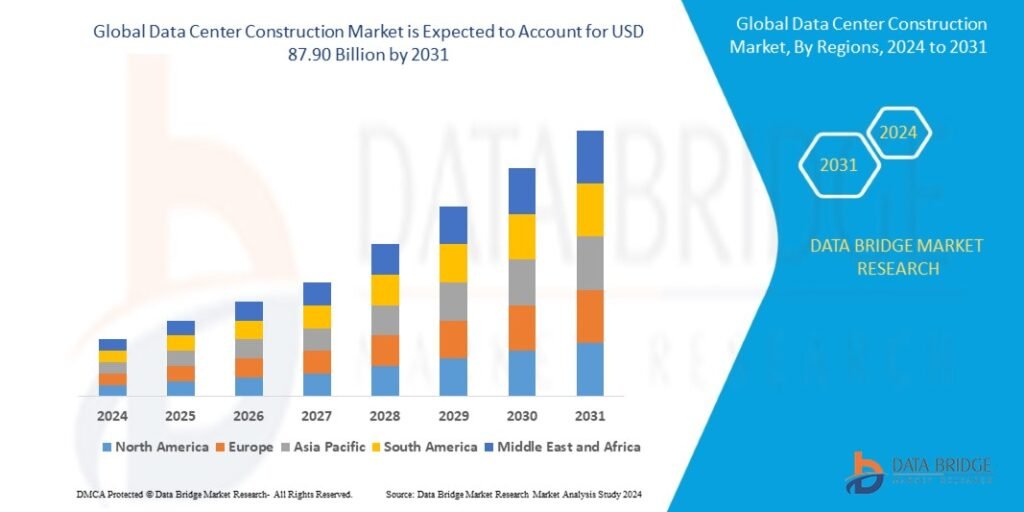
In today’s hyper-connected world, data centers are the foundation of digital transformation, supporting cloud computing, artificial intelligence (AI), big data analytics, and the Internet of Things (IoT). With increasing data demands, businesses and governments are investing heavily in data center construction to ensure scalability, efficiency, and security.
This blog delves into the evolving landscape of data center construction, key trends, challenges, and best practices shaping the industry.
What is Data Center Construction?
Data center construction involves designing, building, and equipping facilities that house computer systems, networking infrastructure, and storage solutions to process and manage vast amounts of data. These centers range from small enterprise facilities to massive hyperscale data centers operated by tech giants like Google, Amazon, and Microsoft.
Types of Data Centers
- Enterprise Data Centers – Built by individual businesses to meet their own computing needs.
- Colocation Data Centers – Third-party facilities that lease space, power, and cooling to multiple tenants.
- Hyperscale Data Centers – Massive facilities designed for cloud computing and high-performance workloads.
- Edge Data Centers – Smaller facilities located closer to end-users to reduce latency and improve performance.
- Modular Data Centers – Pre-fabricated units designed for quick deployment and scalability.
Data Center Construction Market Regional Analysis/Insights
The market is analysed and market size insights and trends are provided by infrastructure type, data center type, organisation size and vertical as referenced above.
The countries covered in the market report are U.S., Canada and Mexico in North America, Germany, France, U.K., Netherlands, Switzerland, Belgium, Russia, Italy, Spain, Turkey, Rest of Europe in Europe, China, Japan, India, South Korea, Singapore, Malaysia, Australia, Thailand, Indonesia, Philippines, Rest of Asia-Pacific (APAC) in the Asia-Pacific (APAC), Saudi Arabia, U.A.E, South Africa, Egypt, Israel, Rest of Middle East and Africa (MEA) as a part of Middle East and Africa (MEA), Brazil, Argentina and Rest of South America as part of South America.
Asia-Pacific is expected to experience substantial growth in the data center construction market, fueled by increased investments and expanding digital infrastructure. The region’s focus on technology and rising economic development creates a favorable environment, positioning APAC as a key player in the data center market.
North America is expected to dominate the data center construction market due to proactive adoption of new technologies and substantial investments in metropolitan infrastructure. Its commitment to technological advancements, coupled with robust urban infrastructure development, positions it as a key hub for data center construction.
Data Center Construction Market Analysis and Size
Advancements in technology have transformed the data center construction market, delivering enhanced efficiency, scalability, and sustainability. Cutting-edge designs, modular construction methods, and energy-efficient solutions drive innovation, meeting the growing demands of businesses for reliable and resilient data storage. This evolution fosters a competitive landscape, pushing the industry toward more agile, cost-effective, and environmentally friendly solutions.
The global data center construction market size was valued at USD 44.44 billion in 2023, will reach USD 87.90 billion by 2031, growing at a CAGR of 8.90% during the forecast period of 2024 to 2031. In addition to the insights on market scenarios such as market value, growth rate, segmentation, geographical coverage, and major players, the market reports curated by the Data Bridge Market Research also include in-depth expert analysis, geographically represented company-wise production and capacity, network layouts of distributors and partners, detailed and updated price trend analysis and deficit analysis of supply chain and demand.
Key Phases of Data Center Construction
1. Planning and Design
- Site selection based on accessibility, power availability, and security.
- Sustainability considerations such as renewable energy integration.
- Scalability to accommodate future growth.
2. Infrastructure Development
- Power Systems: High-capacity electricity grids and backup generators.
- Cooling Systems: Liquid cooling, free-air cooling, or immersion cooling.
- Security Measures: Biometric access controls, surveillance, and fire suppression.
3. Construction and Deployment
- Modular components assembled for faster deployment.
- Network architecture and server installations.
- Redundant systems to ensure uptime.
4. Testing and Commissioning
- Performance validation through stress testing.
- Security audits to prevent cyber threats.
- Final approvals and regulatory compliance.
Trends Shaping Data Center Construction
1. Green Data Centers
- Use of renewable energy sources like solar and wind.
- Energy-efficient cooling solutions to reduce carbon footprints.
2. AI and Automation
- Smart monitoring for predictive maintenance.
- AI-driven workload optimization for efficiency.
3. Modular and Prefabricated Data Centers
- Pre-built modules allow for rapid deployment.
- Cost-effective and scalable solutions.
4. Liquid Cooling Technology
- More efficient than traditional air cooling.
- Essential for high-performance computing applications.
5. Edge Computing Growth
- Demand for low-latency data processing.
- Proliferation of small-scale data centers near end-users.
Challenges in Data Center Construction
1. High Initial Costs
- Land, infrastructure, and equipment expenses are substantial.
2. Power Consumption
- Requires continuous energy supply; dependency on fossil fuels remains a concern.
3. Regulatory Compliance
- Data privacy and security regulations vary across regions.
4. Skilled Workforce Shortage
- Demand for experienced IT professionals and engineers.
5. Environmental Impact
- Cooling systems and energy-intensive operations contribute to carbon emissions.
Best Practices for Data Center Construction
- Site Selection: Choose locations with stable power grids, low disaster risk, and regulatory compliance.
- Energy Efficiency: Invest in sustainable power sources and advanced cooling systems.
- Redundancy Planning: Ensure backup power, failover systems, and disaster recovery measures.
- Security Protocols: Implement multi-layered physical and cybersecurity defenses.
- Scalability Considerations: Design facilities that can expand as data demands grow.
Future of Data Center Construction
The demand for data centers is expected to rise exponentially due to AI, IoT, and 5G expansion. Future advancements will focus on sustainability, automation, and decentralized edge computing to optimize performance and environmental impact.
Data centers will continue to evolve, ensuring that businesses, governments, and individuals remain connected in an increasingly digital world.
Conclusion
Data center construction is at the core of modern technological advancements. As businesses rely more on cloud computing, AI, and big data, the need for innovative, efficient, and sustainable data centers will only grow. By embracing new technologies and best practices, companies can build resilient infrastructure to meet the demands of the future.




